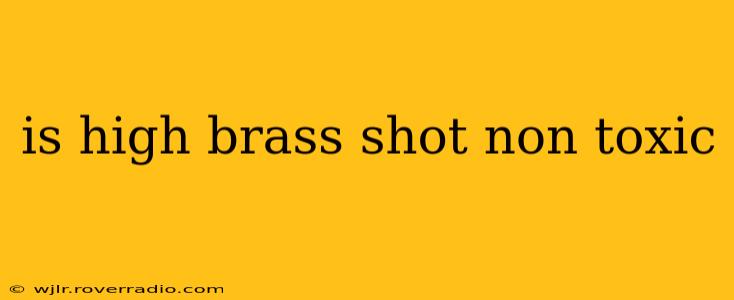Is High Brass Shot Non-Toxic? Understanding the Complexities of Ammunition
The question of whether high brass shot is non-toxic is more nuanced than a simple yes or no. While "high brass" refers to the shell casing and not the shot itself, the type of shot used within high brass shells significantly impacts its toxicity. Let's break down the components and address some common questions.
What Does "High Brass" Mean?
Before diving into toxicity, it's crucial to understand the term "high brass." This refers to the type of shell casing used in shotgun ammunition. High brass shells generally have a thicker, taller casing, often indicating higher pressure and potentially higher velocity. However, high brass itself doesn't determine the toxicity of the shot. The shot material is the key factor.
What Types of Shot Are Used in High Brass Shells?
High brass shells can contain various types of shot, including:
-
Lead Shot: This is the traditional and historically most common type of shot. Lead shot is toxic to wildlife and the environment. Its use is increasingly restricted in many areas.
-
Steel Shot: A common non-toxic alternative to lead. Steel shot is harder than lead, making it suitable for waterfowl hunting but potentially damaging to older shotguns. It's a popular choice for conservation-minded hunters.
-
Bismuth Shot: A denser, non-toxic alternative to lead. Bismuth is more expensive than steel but patterns better and penetrates deeper, making it a preferred option for some hunters.
-
Tungsten-Iron Shot: Another non-toxic alternative, denser than lead, offering excellent penetration and patterns. It is, however, the most expensive option.
-
Other Alloys: Various other non-toxic shot alloys are emerging, incorporating materials like nickel and copper.
Is High Brass Shot Always Non-Toxic? No.
The answer is a definitive no. High brass shells can contain lead shot, which is highly toxic. Therefore, simply knowing a shell is "high brass" doesn't guarantee it's non-toxic. You must check the ammunition packaging to determine the shot material. Look for clear labeling specifying "non-toxic" or the type of shot used (e.g., steel, bismuth).
What are the Environmental Concerns of Toxic Shot?
Lead shot poses a significant threat to wildlife, particularly waterfowl. Birds can ingest lead shot, mistaking it for grit, leading to lead poisoning and death. This has devastating effects on bird populations and ecosystems.
How Can I Choose Non-Toxic Ammunition?
Always check the ammunition packaging. Look for clear labeling indicating the type of shot used. Many manufacturers clearly state whether their ammunition is non-toxic and suitable for environmentally sensitive areas. Responsible hunters prioritize non-toxic ammunition to minimize environmental impact.
Are there specific regulations regarding non-toxic shot?
Regulations surrounding the use of lead shot vary considerably by region and hunting type. Some areas have completely banned lead shot for waterfowl hunting, while others have restrictions based on the type of firearm or hunting area. It's crucial to check your local and national regulations before purchasing and using any ammunition.
In conclusion, the "high brass" designation only refers to the shell casing; it does not indicate whether the shot inside is toxic or not. Always check the packaging to confirm the type of shot and its toxicity level to ensure you are making an environmentally responsible choice.
